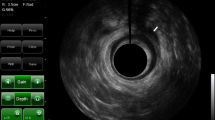Abstract
Purpose
The study was designed to determine the effect of further vaginal delivery on anal sphincter function in women after apparently uncomplicated primiparous forceps delivery.
Methods
Fifty-two secundigravid women whose first child was forceps-assisted were compared with a control group of 20 women who had undergone spontaneous first vaginal delivery. Both groups were studied antenatally and again at 12 weeks after second delivery using a standardized bowel function questionnaire, endoanal ultrasound, and anal manometry. The primary outcome was fecal incontinence score after second delivery.
Results
Before second delivery, 20 of 52 (39 percent) of the forceps group and 3 of 20 (15 percent) control subjects (P = 0.103) reported minor alteration in fecal incontinence. Endoanal ultrasound was more frequently abnormal (38/52 (73 percent) vs. 6/20 (30 percent); P = 0.002), and median anal canal squeeze (71 vs. 104 mmHg; P = 0.004) and resting pressures (43 vs. 58 mmHg; P = 0.004) were lower in the forceps group. There was no difference in continence score between first and second delivery for the forceps group (P = 0.19) group or control subjects (P = 0.18). However, 10 of 38 (26 percent) women with an abnormal endoanal ultrasound after first forceps delivery developed new or worsening symptoms after second delivery.
Conclusions
One-quarter of women with occult anal sphincter injury after first forceps delivery experienced some minor alteration in fecal continence after the second delivery.

Similar content being viewed by others
References
Donnelly VS, Fynes M, Campbell DM, Johnson H, O’Connell PR, O’Herlihy C. Obstetric events leading to anal sphincter damage. Obstet Gynecol 1998;92:955–61.
Sultan AH, Kamm MA, Hudson CN, Bartram CI. Third degree obstetric anal sphincter tears: risk factors and outcome of primary repair. BMJ 1994;308:887–91.
Snooks SJ, Swash M, Mathers SE, Henry MM. Effect of vaginal delivery on the pelvic floor: a 5-year follow up. Br J Surg 1990;77:1358–60.
Fitzpatrick M, Fynes M, Cassidy M, Behan M, O’Connell PR, O’Herlihy C. Prospective study of the influence of parity and operative technique on the outcome of primary anal sphincter repair following obstetrical injury. Eur J Obstet Gynecol Rep Biol 2000;89:159–63.
Sultan AH, Kamm MA, Hudson CN, Bartram CI. Anal sphincter disruption during vaginal delivery. N Engl J Med 1993;329:1905–11.
Haadem K, Dahlstrom JA, Lingman G. Anal sphincter function after delivery: a prospective study in women with sphincter rupture and controls. Eur J Obstet Gynecol Rep Biol 1990;35:7–13.
Sultan AH, Kamm MA, Bartram CI, Hudson CN. Anal sphincter trauma during instrumental delivery. Int J Gynecol Obstet 1993;43:263–70.
Sultan AH, Johanson RB, Carter JE. Occult anal sphincter trauma following randomized forceps and vacuum delivery. Int J Gynecol Obstet 1998;61:113–9.
Johanson RB, Menon BK. Vacuum extraction versus forceps for assisted vaginal delivery. Cochrane Database Syst Rev 2000;2:CD000224.
Bofill JA, Rust OA, Schorr SJ, et al. A randomized prospective trial of the obstetric forceps versus the M-cup vacuum extractor. Am J Obstet Gynecol 1996;175:1325–30.
Fynes M, Donnelly V, Behan M, O’Connell PR, O’Herlihy C. Effect of second vaginal delivery on anorectal physiology and fecal continence: a prospective study. Lancet 1999;354:983–6.
Vaizey CJ, Carapeti E, Cahill JA, Kamm MA. Prospective comparison of fecal incontinence grading systems. Gut 1999;44:77–80.
Jorge JM, Wexner SD. Etiology and management of fecal incontinence. Dis Colon Rectum 1993;36:77–97.
Rothbarth J, Benelman WA, Meijerink WJ, et al. What is the impact of fecal incontinence on quality of life? Dis Colon Rectum 2001;44:67–71.
Williams M, Barlow J, Hobson A, Scott N, Irving M. Manometric asymmetry in the anal canal in controls and patients with fecal incontinence. Dis Colon Rectum 1995;38:1275–80.
Perry RE, Blantchford GJ, Christensen MA, Thorson AG, Attwood SE. Manometric diagnosis of anal sphincter injuries. Am J Surg 1990;159:112–7.
Bartram CI, Frudinger A. Handbook of anal endosonography. Petersfield, UK: Wrightson Biomedical Publishing Ltd., 1997.
Bartram CI, Sultan AH. Anal endosonography in fecal incontinence. Gut 1995;37:4–6.
Sentovich S, Wong D, Blatchford G. Accuracy and reliability of transanal ultrasound for anterior sphincter injury. Dis Colon Rectum 1998;41:1000–4.
O’Driscoll, Meagher D, Robson M. Active management of labor. 4th ed. London: Mosby, 2003.
Christianson LM, Bovbjerg VE, McDavitt EC, Hullfish KL. Risk factors for perineal injury during delivery. Am J Obstet Gynecol 2003;189:255–60.
de Leeuw JW, Struijk PC, Vierhout ME, Wallenburg HC. Risk factors for third degree perineal ruptures during delivery. BJOG 2001;108:383–7.
de Parades V, Etienney I, Thabut D, et al. Anal sphincter injury after forceps delivery: myth or reality? A prospective ultrasound study of 93 females. Dis Colon Rectum 2004;47:24–34.
Groom KM, Paterson-Brown S. Can we improve the diagnosis of third degree tears? Eur J Obstet Gynecol Reprod Biol 2002;101:19–21.
Andrews V, Sultan AH, Thakar R, Jones PW. Occult anal sphincter injuries - myth or reality? BJOG 2006;113:195–200.
Pollack J, Nordenstam J, Brismar S, Lopez A, Altman D, Zetterstrom J. Anal incontinence after vaginal delivery: a five-year prospective cohort study. Obstet Gynecol 2004;104:1397–402.
Fornell EU, Matthiesen L, Sjödahl, Berg G. Obstetric anal sphincter injury ten years after: subjective and objective long-term effects. BJOG 2005;112:312–6.
Author information
Authors and Affiliations
Corresponding author
Additional information
Supported by the Irish Health Research Board.
About this article
Cite this article
Mahony, R., Behan, M., O’Connell, P.R. et al. Effect of Second Vaginal Delivery on Anal Function in Patients at Risk of Occult Anal Sphincter Injury after First Forceps Delivery. Dis Colon Rectum 51, 1361–1366 (2008). https://doi.org/10.1007/s10350-008-9302-8
Received:
Revised:
Accepted:
Published:
Issue Date:
DOI: https://doi.org/10.1007/s10350-008-9302-8




